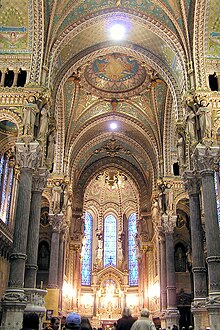Notre-Dame de Fourvière
Notre-Dame de Fourvière is a Roman Catholic votive and pilgrimage church on the Fourvière hill in Lyon . It was built from 1872 and consecrated in 1896 . The following year it was raised to the rank of minor basilica . Since 1998, it has been a UNESCO World Heritage Site along with other historical sites in Lyon .
history
Fourvière (from Latin forum vetus , "old forum ") was the center of Lugdunum in Roman antiquity . In the 11th century the city began to grow again after centuries of loss of importance. However, the new center was created at the foot of the Fourvière hill near the banks of the Saône . The first Lady Chapel was built on the ruins of the old forum in 1168.
When Lyon was hit by a plague epidemic, in 1643 the city council promised an annual thanksgiving procession to the Fourvière chapel in the event that the epidemic would quickly end. This procession of the mayor and city councilor still takes place on September 8th ( the birth of Mary ). Since the vow, the pilgrimages of foreign pilgrims have also increased and the chapel had to be rebuilt and expanded several times.
In 1830 the bell tower of the chapel was demolished because it was in disrepair and later replaced by a new, higher tower in neo-Romanesque form, the top of which was crowned with a gilded bronze statue of Our Lady by Joseph-Hugues Fabisch . Its consecration on December 8, 1852 ( Mary's Conception ) was affected by a storm and the planned fireworks had to be canceled. The citizens of Lyon then lit their windows with thousands of candles - the origin of the city festival Fête des Lumières, which is still celebrated today .
In the Franco-Prussian War of 1870/71, the citizens of Lyon made the vow to enlarge and beautify the sanctuary of Fourvière if their city was spared from Prussian occupation. The wish came true, and in 1872 the foundation stone of the new church was laid to the north of the old chapel.
Architecture and equipment
The plans for Notre-Dame de Fourvière were created by Pierre Bossan , who had previously also designed the pilgrimage basilica of Ars ; with the completion was also Louis Sainte-Marie-Perrin commissioned. The building shows the historicist - eclectic style typical of the French sacred buildings of this time with great attention to decorative detail. Romanesque and Byzantine architectural forms are predominant .
The basilica is a three-aisled hall church made of white stone . The external effect is determined by the unusual ensemble of four octagonal corner towers, which close horizontally with railings and are only crowned by very slim copper helmets with crosses. They are supposed to be reminiscent of a medieval castle, but they also earned the building the nickname "upside down elephant". Although there is no transept, the interior of the church is divided into a nave and choir by an indicated crossing . This closes with a round apse pierced by five windows .
The furnishing is abundant , and it took decades to complete after the consecration. Arches and columns are lavishly decorated with capitals , friezes , cornices , statues of angels and saints. Vaults and walls are decorated with multicolored, shiny gold mosaics and paintings. The numerous large stained glass windows show scenes from the Bible - above all from the life of Mary - and French church history.
The organ was last restored in 1996 by the organ builder Jean Renaud (Nantes). The instrument has 47 stops on three manuals and a pedal .
|
|
|
|
|||||||||||||||||||||||||||||||||||||||||||||||||||||||||||||||||||||||||||||||||||||||||||||||||||||||||||||||||||||||||||||||||||||||||||||||||||||||||||||
-
Couple
- Normal coupling: II / I, III / I, III / II, I / P, II / P, III / P
- Sub-octave coupling: II / I, III / I, III / II,
- Super octave coupling: II / I, III / I, III / II, III / P
effect
The Notre-Dame de Fourvière basilica is one of the landmarks of Lyon, simply because of its location. At the time of its creation, like the Sacré-Cœur in Paris , it was also intended as a monument of the Renouveau catholique , of resistance against the secular republican state and as a symbolic subordination of the city to the Mother of God . As a secular, anticlerical counter-accent, the “little Eiffel Tower ”, the Tour métallique de Fourvière , a few meters higher, was built in the immediate vicinity from 1892–94 .
literature
- Elisabeth Hardouin-Fugier: Qui a renversé l'éléphant? Constructeurs et tracteurs de la Basilique de Fourvière (1870-1896) . In: Cahiers d'Histoire Lyon , Vol. 27 (1982), No. 2, pp. 99-124.
Web links
Individual evidence
- ↑ list
- ↑ UNESCO
- ↑ Information on the organ ( page no longer available , search in web archives ) Info: The link was automatically marked as defective. Please check the link according to the instructions and then remove this notice. (French)
- ↑ There is no evidence for the anti-clerical intention.
Coordinates: 45 ° 45 ′ 44.6 " N , 4 ° 49 ′ 20.7" E


